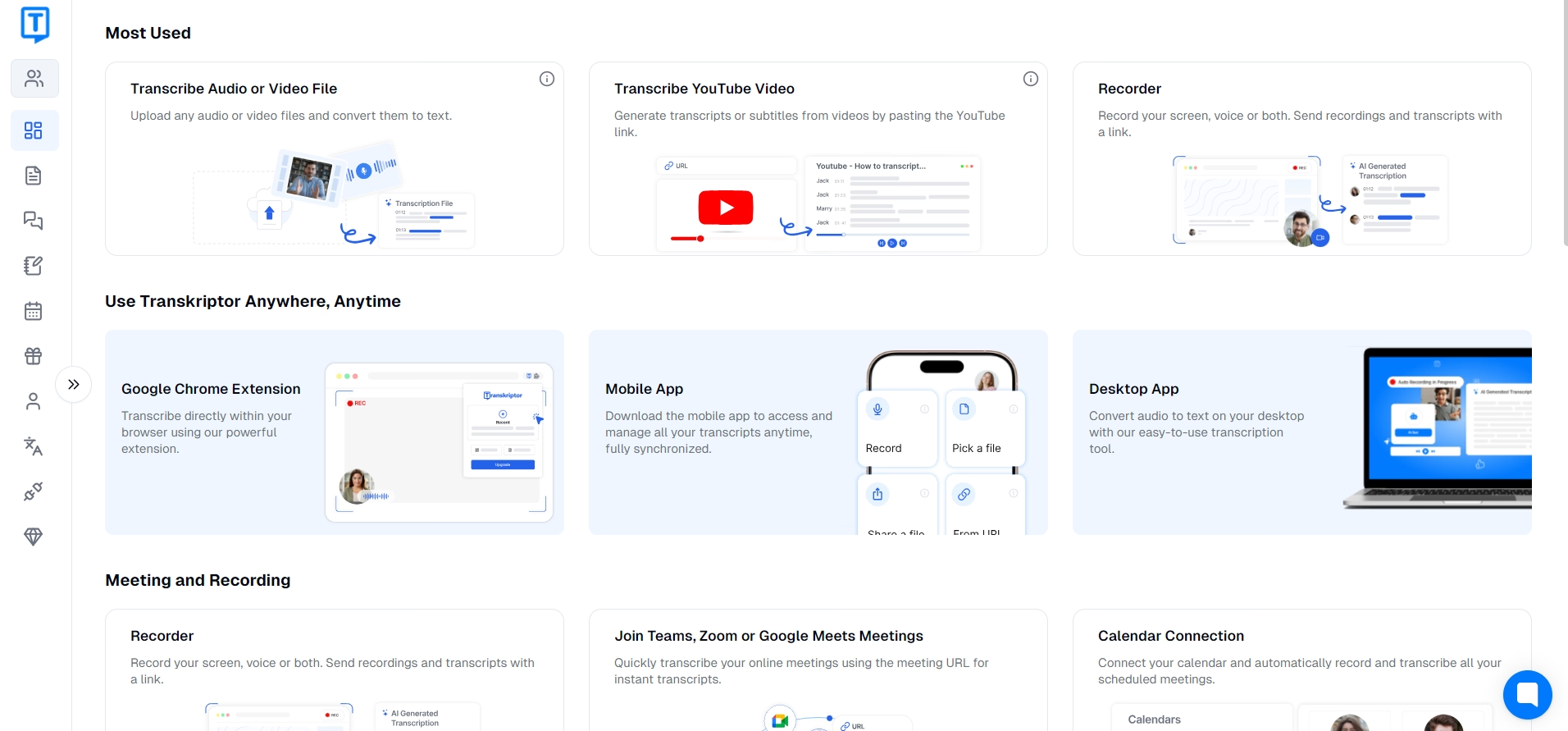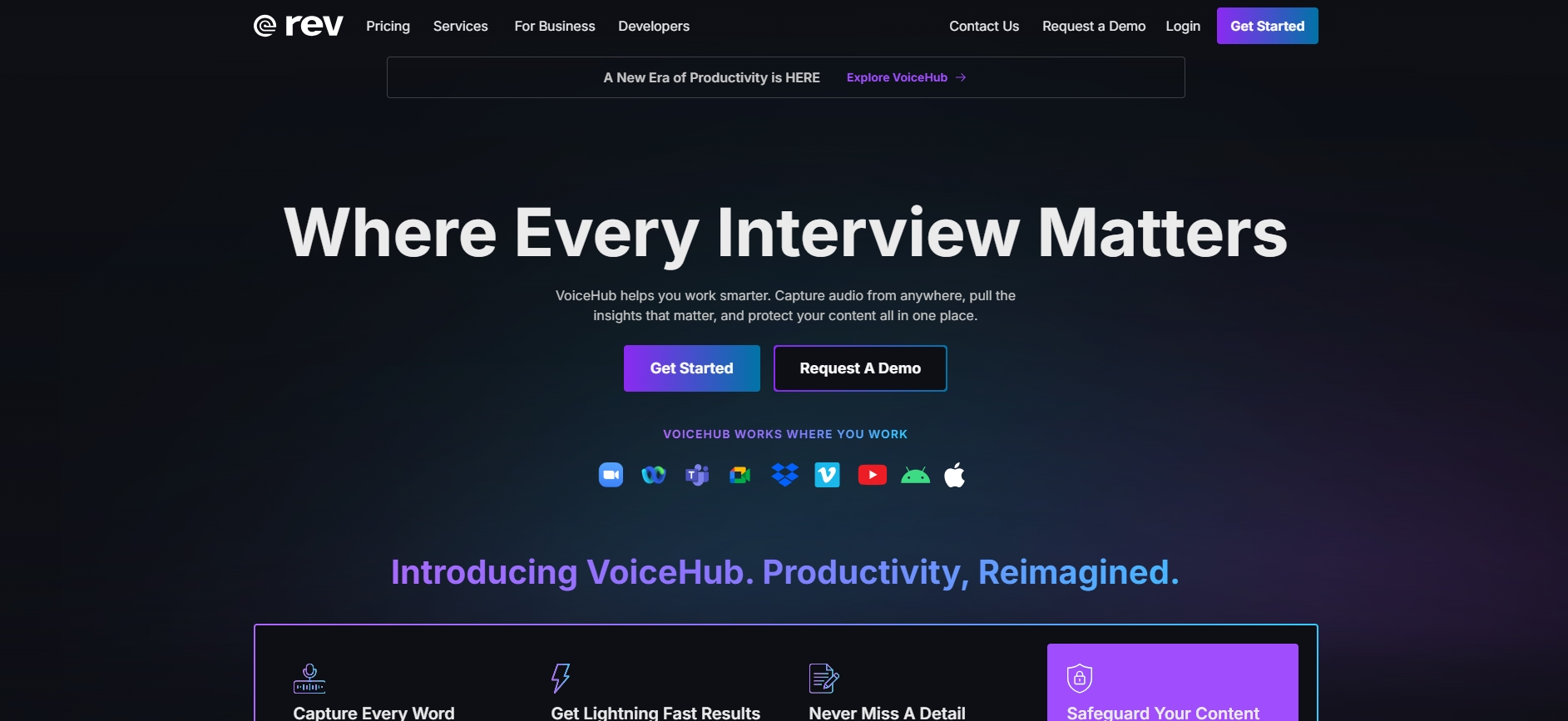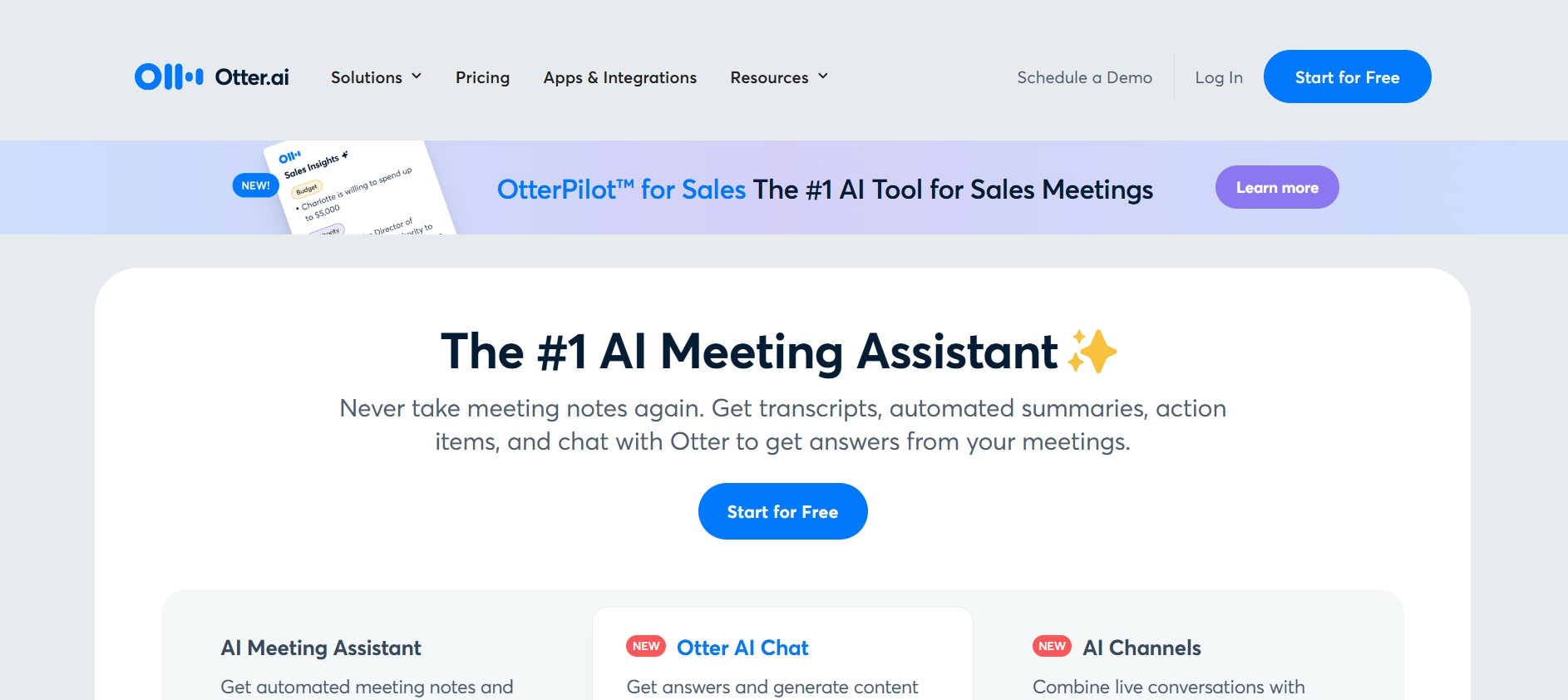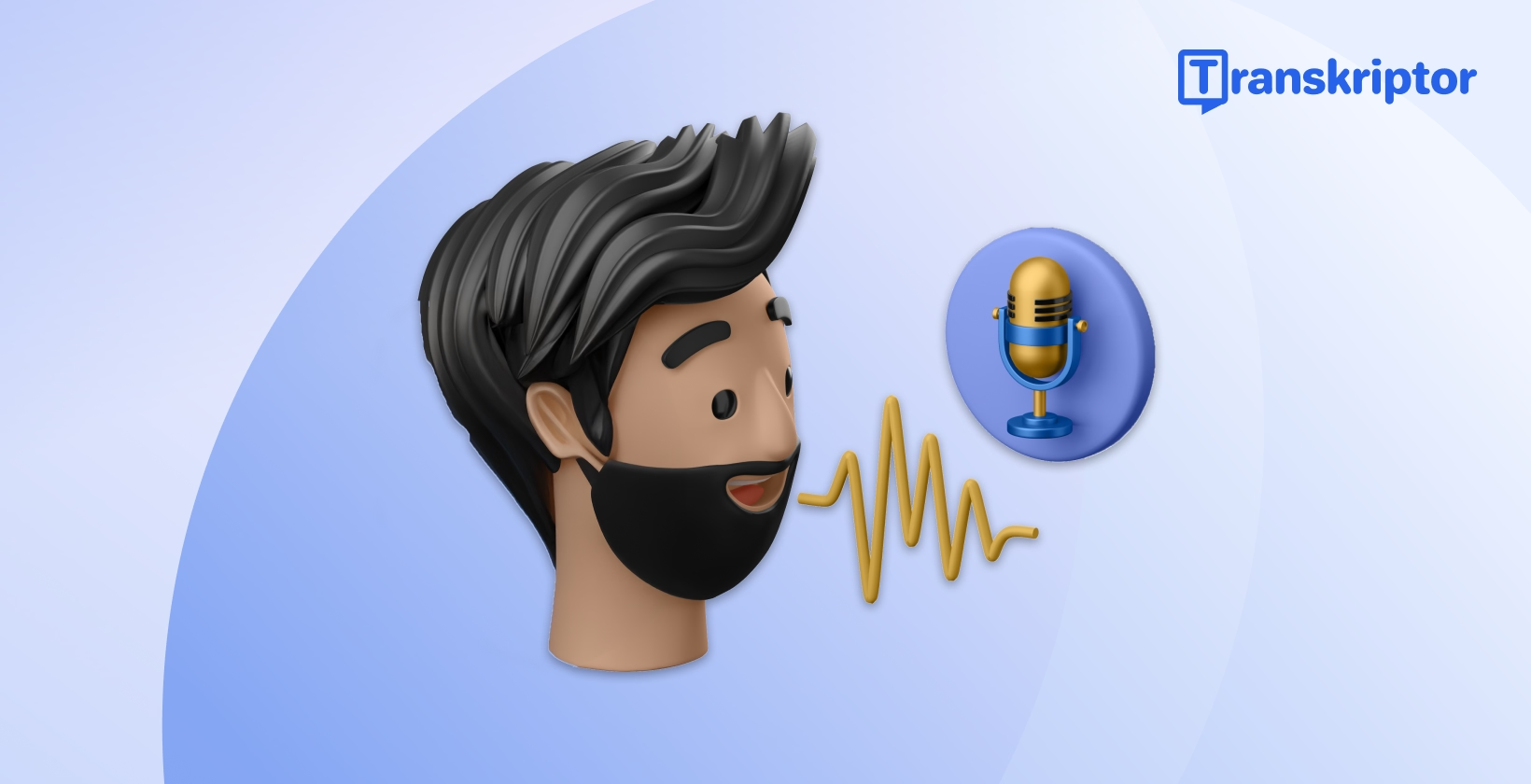The 20 best speech recognition software in 2025 are below.
- Transkriptor: An online transcription tool harnessing artificial intelligence for fast and accurate transcription. It is ideal for various audio files like interviews and podcasts.
- Siri: Siri is a virtual assistant developed by Apple.
- Otter: Otter.ai is a cloud-based speech-to-text software.
- Rev: Rev.ai offers speech-to-text APIs for speech recognition software.
- Gboard: Gboard integrates Google’s speech recognition technology for voice-typing.
- Google Now: Google Now is a voice-activated assistant that provides information based on user habits.
- Winscribe: Winscribe Dictation is a professional speech recognition and dictation software.
- Amazon Lex: Amazon Lex is an AI service that creates chatbots and voice applications.
- Google Docs Voice Typing: Google Docs Voice Typing is a feature within Google Docs that dictates documents.
- Speechnotes: Speechnotes is a speech-enabled online notepad that can transcribe speech.
- Dragon Anywhere: Dragon Anywhere is a professional cloud-based dictation software.
- Braina: Braina is a personal assistant and voice recognition software for Windows computers.
- Beey: Beey is an online dictation service.
- Philips SpeechLive: Philips SpeechLive is a cloud-based dictation software.
- Google Cloud Speech API: Google Cloud Speech API enables developers to convert audio to text.
1. Transkriptor

Transkriptor is a strong AI-powered transcription service with up to 99% accuracy. It is available on Android and iPhone mobile devices as a Google Chrome extension and webpage. Transkriptor makes transcriptions from any link and turns live voice into text, such as meetings, interviews, and lectures.
Customers rate the program 4.5/5 on more than 50 Capterra evaluations and 4.8/5 on more than 100 Trustpilot ratings.
The AI-powered transcription tool provides extensive language support in over a hundred languages and allows users to simultaneously create textual content in numerous languages. Language coverage is a crucial factor to consider while developing dictation software.
2. Siri

Siri is a virtual assistant that uses speech recognition technology to control voice. Apple developed it, and it is available on Apple devices such as iPhones, iPads, Macs , and Apple Watches. Users give Siri voice commands to perform actions.
Siri's pros are that it is user-friendly, integrates with Apple devices, has a good contact center, and provides regular updates. Its cons are limited usage of Apple devices and occasional misinterpretations.
3. Rev

Rev is a company for speech transcription. Rev.ai offers speech-to-text APIs for speech recognition software. The key features of Rev.ai are automatic transcription, multiple language support, timestamps, and speaker indication. Rev.ai supports various languages and dialects.
The pros of Rev.ai are high accuracy rates, ease of integration, and scalability. The cons are its dependence on audio quality and limited functionality without the internet.
Rev.ai offers a free plan with limited transcription minutes. Rev.ai has different paid plans depending on the transcription minutes. Ratings of Rev.ai highlight its accuracy level and ease of use. Positive reviews say the transcription speed is high.
4. Otter

Otter.ai is cloud-based speech-to-text software. Its key features are live transcription, speaker identification, a search function, and collaboration. Otter recognizes different speakers and indicates each one.
Otter's pros are its high accuracy and ease of use. Its cons are limited offline functionality and dependence on an internet connection.
Otter.ai provides a free plan with limited minutes per month. It has different paid plans. Paid plans offer more minutes and additional features. Otter creates transcriptions with multi-speaker audio.
Users give positive ratings to Otter.ai. They appreciate its high accuracy and convenience. Users highlight Otter’s user-friendly interface. Some users mention that there are occasional inaccuracies in noisy environments.
5. Philips SpeechLive
Philips SpeechLive is cloud-based dictation software. It is preferred by professionals who require efficient document creation. Its key features are live transcription and cloud-based, offering real-time speech recognition technology.
The pros of Philips SpeechLive are flexibility and efficiency. The cons are the difficulty of use and pricing.
Philips SpeechLive operates on a subscription model based on the transcription volume. It also has a free trial for users to try the software. Positive user feedback highlights the convenience of the mobile app for dictation. Negative user feedback includes reliance on an internet connection.
6. Gboard
Gboard is a Google virtual keyboard app available on Android and iOS devices. It integrates Google’s speech recognition technology to facilitate voice typing. The key features of Gboard are voice typing, glide typing, emoji and GIF search, and integration with Google Translate.
Gboard's pros are its versatility and integration with Google services. Its cons are limited performance and internet requirements.
Gboard is free software with high ratings on Google Play and App Store. Users appreciate its user-friendly design and the convenience of voice typing. However, Gboard occasionally glitches and lags.
7. Google Now
Google Now is a voice-activated assistant that provides information based on user habits. Its key features are proactive information cards and voice commands. Google Now displays information cards based on user habits and supports voice commands to perform various tasks.
The pros of Google Now are ease of use and customization. The cons of Google Now are limited offline functions and limited voice commands.
Google Now is a free service. It is available both on the Google Play Store and the App Store. Ratings and feedback praise its innovative approach to speech recognition technologies.
8. Winscribe
Winscribe Dictation is a professional speech recognition and dictation software. Healthcare, legal, and insurance industries highly prefer Winscribe. The key features of Winscribe are mobile support and speech recognition quality. Winscribe is compatible with smartphones.
The pros of Winscribe are flexibility and customization. The cons of Winscribe are cost and difficulty of use, compared to other dictation services.
Pricing for Winscribe depends on the specific needs of the users. Winscribe offers a quote-based pricing model. Ratings for Winscribe Dictation are positive in professional industries. Negative feedback includes difficulty in using it without a training process.
9. Amazon Lex
Amazon Lex is an AI service that creates chatbots and voice applications. Its key features are high-quality speech recognition and natural language understanding. Amazon Lex helps create conversational bots that engage in dialogue.
The pros of Amazon Lex are scalability and integration. The cons are the difficulties of use and costs.
Amazon Lex's pricing depends on users' needs. It has a free tier for the first 12 months, and paid plans are changed according to users' requirements. Unlike other speech recognition services, Amazon Lex provides a framework for building interactive apps.
Ratings for Amazon Lex are generally positive among developers. Users highlight its effectiveness in creating responsive chatbots. Negative feedback indicates its difficulty to use.
10. Google Docs Voice Typing
Google Docs Voice Typing is a feature within Google Docs. Students, writers, and professionals prefer Google Docs Voice Typing to dictate documents. The key features are functionality and a user-friendly interface. The feature is accessible with a click on the microphone icon in Google Docs.
The pros of Google Docs Voice Typing are its ease of use and accessibility. The cons are its reliance on an internet connection and limited use.
Google Docs Voice Typing is a free feature within Google Docs. Users access the feature with a Google account for free. Positive feedback appreciates its integration into the daily workflow without an additional cost. Negative feedback includes limitations in voice recognition accuracy compared to other dictation software.
11. Speechnotes
Speechnotes is a speech-enabled online notepad that helps users transcribe speech to text. Its key features are high accuracy and punctuation commands.
The pros of Speechnotes are its user-friendly interface and efficiency. The cons are its reliance on an internet connection and limited understanding of dialects.
Speechnotes is free to use with ads. The paid version provides additional features, and it does not include ads. Ratings and feedback for Speechnotes are generally positive. Users appreciate its simplicity and accuracy.
12. Dragon Anywhere
Dragon Anywhere is a professional cloud-based dictation software that allows users to create and edit documents on iOS and Android devices. Its key features are voice formatting and editing options.
Dragon Anywhere's pros are customization and continuous dictation. Its cons are that it is subscription-based and requires an internet connection.
Pricing for Dragon Anywhere depends on a monthly or annual subscription. Users choose a payment plan according to their needs. User feedback praises Dragon Anywhere’s ability to adapt to the user’s voice. Negative feedback includes the software's pricing.
13. Braina
Braina is a personal assistant and voice recognition software for Windows computers. Its key features are an AI chatbot, task automation, and remote control. Braina answers users' questions with contextual understanding. Users access and control their computers via the Braina app.
The pros of Braina are custom commands and flexible use. The cons of Braina are high prices.
Braina has both free and paid versions. The paid version has a subscription model with monthly or annual payments. User feedback praises Braina’s ease of use and efficiency. Negative feedback focuses on occasional misunderstandings due to speech recognition errors.
14. Beey
Beey is an online dictation service. The key features of Beey are time stamping and speaker identification. Beey adds automatic timestamps to transcriptions. Beey identifies and differentiates between speakers in a conversation.
The pros of Beey are user interface and speed. The cons of Beey are internet reliance and limited editing features.
Beey operates on a pay-per-use basis. Pricing depends on the length of the audio or video file. Positive user feedback highlights Beey’s convenience for interview and lecture transcription. Negative feedback mentions Beey's high pricing methods.
15. Google Cloud Speech API
Google Cloud Speech API enables developers to convert audio to text. The API recognizes over 120 languages. The key features of Google Cloud Speech API are real-time speech recognition, automatic speech recognition (ASR), and customization.
The pros of Google Cloud Speech API are scalability and flexibility. The cons are pricing and complexity.
Google Cloud Speech API offers a free tier with limits. Pricing varies according to the amount of the audio. Positive user feedback includes high accuracy levels and customization options. Negative user feedback focuses on the complexity of the interface and high pricing methods.
What is Speech Recognition?
There are various types of speech recognition that enable converting spoken content into fine-tuned written text. Speech recognition technology analyzes sound waves and uses algorithms to convert sounds into text.

People also refer to speech recognition as automatic speech recognition (ASR) and speech-to-text. Advanced speech recognition systems understand the language model and handle various speaking accents, dialects, and vocabulary.
Is Speech Recognition the Same as Dictation?
No, speech recognition is not the same as dictation. Although similar, they have slight differences. Speech recognition is the broad technological capacity of computers to recognize human speech.
It is an umbrella term for interpreting spoken language by a machine. Dictation refers to the process of converting speech into text. Dictation is a subset of speech recognition.
How to Choose a Voice Recognition Software?
When choosing voice recognition software or best text to speech software, ensure it is accurate, language-supporting, compatible, and fast. Look for software that accurately recognizes and transcribes speech. Ensure that the speech recognition engine supports the required languages or dialects. Make sure that the software is compatible with the operating system.
Some software, like dictation software for mac, only works on specific operating systems. To increase productivity, the software must transcribe speech to text. Check the software's capacities and features before starting to use it.


